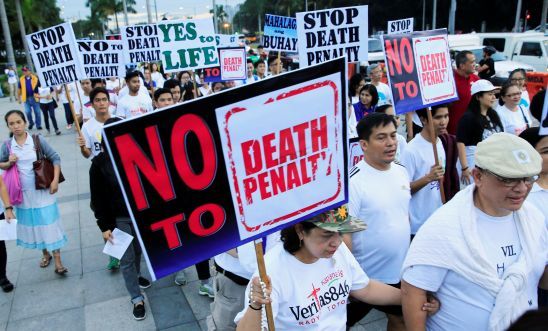
The death penalty: what’s changed since 1977?

It’s 40 years since we created the world’s first international manifesto to end the death penalty. Since 1977, we have seen huge amounts of progress in the campaign to end the use of the death penalty around the world. We’re so much closer to seeing the end of this horrific punishment – which we consider the ultimate denial of human rights. But we’re not quite there yet.
Do something now
Stop the executions in the Maldives
The Maldives is set to start using the death penalty again after 60 years of not executing anyone. Three men now face execution by hanging.
Stop 14 men being executed in Saudi Arabia
14 men are due to be beheaded for allegedly being involved in anti-government protests, after they were tortured into confessing.
40 years of campaigning to end the death penalty
“When the state uses its power to end the life of a human being, it is likely that no other right is inviolate. The state cannot give life, it should not presume to take it away.”
Amnesty International's Declaration of Stockholm
In 1977, we drafted the Declaration of Stockholm – a declaration calling on every government around the world to stop using the death penalty.
Why did we decide to campaign to stop the death penalty?
The death penalty the ultimate denial of a basic human right – the right to life. The state shouldn't be able to take that away from you as a punishment within a criminal justice system. The death penalty also denies someone the right to be free from torture. It is a violent irreversible punishment.
We oppose the use of the death penalty in every single case. No matter what the crime, who the alleged criminal is, or the method proposed to execute them – we always stand against it.
- The death penalty is irreversible and mistakes happen. Execution is the ultimate, irrevocable punishment: the risk of executing an innocent person can never be eliminated. Since 1973, for example, 150 US prisoners sent to death row have later been exonerated (cleared of the crime/s they were, or were due to be, executed for). Many people have been executed despite serious doubts about their guilt.
- It doesn't deter crime. Countries that execute commonly cite the death penalty as a way to deter people from committing crime. This claim has been repeatedly discredited, and there is no evidence that the death penalty is any more effective in reducing crime than imprisonment.
- It's often used within skewed justice systems. Some of the countries executing the most people have deeply unfair legal systems. The ‘top’ three executing countries – China, Iran and Iraq – have issued death sentences after unfair trials. Many death sentences are issued after ‘confessions’ that have been obtained through torture.
- It's discriminatory. You are more likely to be sentenced to death if you are poor or belong to a racial, ethnic or religious minority because of discrimination in the justice system. Also, poor and marginalized groups have less access to the legal resources needed to defend themselves.
- It's used as a political tool. The authorities in some countries, for example Iran and Sudan, use the death penalty to punish political opponents.
Documenting executions
One of the ways we protect human rights is by reporting when governments abuse them. Our research is used to help hold abusers to account in courts around the world.
Under international law, the death penalty is banned from use - except during times of war - under:
- The Second Optional Protocol to the International Covenant on Civil and Political Rights
- Protocol No. 6 to the European Convention on Human Rights
- The Protocol to the American Convention on Human Rights to Abolish the Death Penalty.
The European Convention on Human Rights (Protocol No. 13) bans use of the death penalty at all times, even during war.
Although international law says that the death penalty can be used for the most serious crimes, like murder, we believe that the death penalty is never the answer.
In 1979 we started publishing statistics showing which countries were executing, how and why. We have reported on this every year ever since, and have become a key global authority on monitoring and reporting on death sentences and executions carried out by governments worldwide.
See death penalty statistics from 2016
40 years on...fewer states are executing
Back in 1977, the death penalty was legal in most of the world, with the exception of 16 countries who had outlawed it.
Now, in 2017, the death penalty is illegal in 105 countries. A further 36 countries have either repealed the death penalty for ‘ordinary crimes’ such as murder, or effectively stopped using the death penalty although it remains legal.
See how countries around the world used the death penalty now
Last year, only 23 countries actually executed people. The majority of executions took place in a small group of countries – China, Iran, Saudi Arabia, Iraq and Pakistan.
We are calling on all countries that still have the death penalty in their laws to make it illegal. Where it is still illegal, we call on states to stop using the punishment and establish an official moratorium as a step towards making it illegal.
With your help, we won’t need another 40 years to reach our goal of ending the death penalty for good.